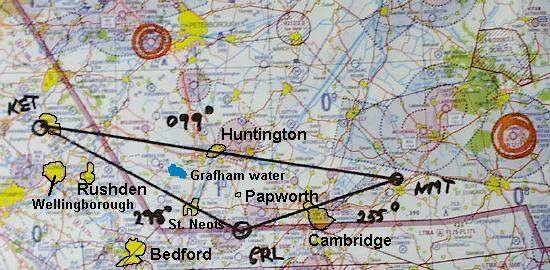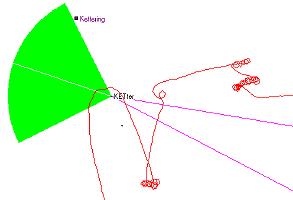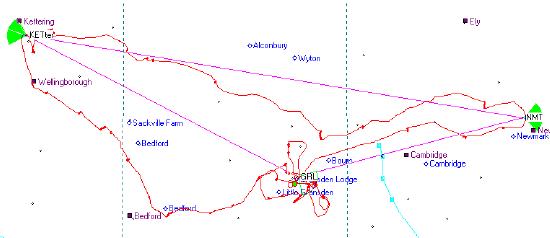
Once again it was my turn to fly. The Club task was a 158 km speed task with two turn points: Kettering and Newmarket. There was little to worry about in the way of NOTAMS: just parachutes at Sibson and large models at Honington, and they were pretty far away from the task routing. There was no restricted airspace in the immediate area either.

The launch was delayed into early afternoon while conditions became soarable. I made a start about 20 minutes after the gate opened, at 14:08, heading directly toward Kettering past St. Neots and Grafham Water, but realized I'd got it wrong when I found myself at barely 2000 ft and only half way to St. Neots. At this point I flew back to Gransden Lodge, regained a sensible start height and restarted at 14:31 and 3000 ft. This time I took a more indirect route, following cloud streets past the north edge of Bedford and then bending north to Rushden, where the streets ended and conditions became blue. Here I met up with an ASW-19 and we headed for Kettering via scattered clouds and blue thermals. A gentle, almost neutral thermal over Wellingborough gave me time to assess the way ahead.
 |
|
Track detail showing the tactical mistake. |
The ASW-19 headed east of the turn point through moderate sink, aiming for a useful-looking cloud with a gaggle of three or four gliders under it. I calculated that I could go directly to the turn point, an intersection on the south west side of Kettering, and still get to the cloud which I thought was on the outbound track to Newmarket. I did this, finding reduced sink on my way to the turn point and arriving at the cloud at 1900 ft, more or less at the same time as the gaggle left it. From this vantage point I realised I'd made a tactical mistake which cost me 8 minutes and probably two places in the day's results: this cloud was really on the inbound track and another, much better, cloud to the east of Kettering on the outbound track would have been reachable from the turn point. I'd spotted it during the run in but discarded it as being too far off track. I corrected the error by moving to the better cloud and was rewarded by a fast climb to 4400 feet, my highest climb of the trip.
From here I followed isolated clouds down to and along the east shore of Grafham Water and round the south side of Huntington. During this run the predominantly easterly breeze swung to the north and strange, probably shear wave related, bars of cloud formed. After a struggle up from 1600 ft to the east of Papworth I got up onto this pattern and found that each bar had an energy line well out in front of its northern edge and another under its southern edge. In consequence I got to Newmarket fairly easily by alternately running east along a bar and then stepping south onto the next whenever I found myself too far north of track. I got round NewMarket after a 4 kt climb to 3400 ft under a dark patch in the last bar and then moved back to the same bar as the start of my run back home.
By now it was getting quite late: it was 17:00 by the time I was climbing again, the gloom was gathering as a layer of cirrus thickened overhead and the day looked to be dying. A slow two kt climb saw me back at 2500 ft and I started a very slow creep home past Cambridge, hoping I would be able to make it home. This looked more likely after a slow climb to 2800 ft above the north west edge of Cambridge combined with a lightening of the gloom. Then the discovery of a useful energy line that allowed me to maintain height past Bourne made it certain that I was in. I crossed the A1198 out of Bourne airspace at 2000 ft and, miles too late, accelerated to cross the finish line at 120 kts and 850 ft after 2 hours 48 minutes for a handicap speed of 60.4 kph and 22nd place.

That evening I got a lecture from Mike Roberts, one of the instructors, over several beers about doing a poor finish: far too high and too slow in his opinion. There's an aerodynamic limit: if you're high and already travelling near Vne, the maximum speed the glider can be flown at, you can't go lower without exceeding Vne and running the risk of over stressing the airframe. To break this barrier you have to start to accelerate quite a long way back up the track in order to arrive lower for that spectacular finish.